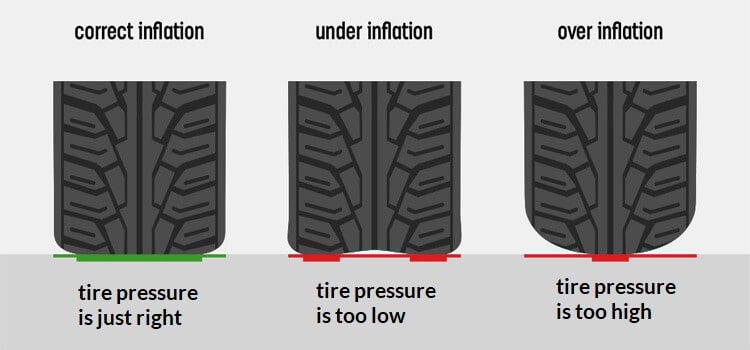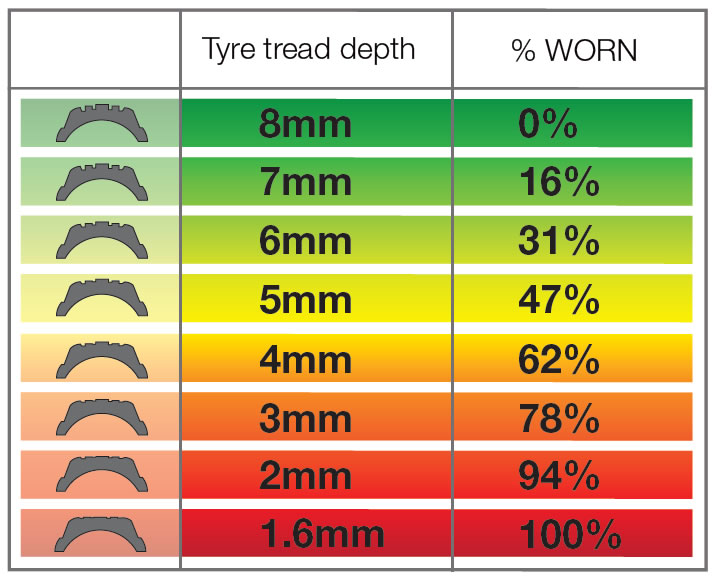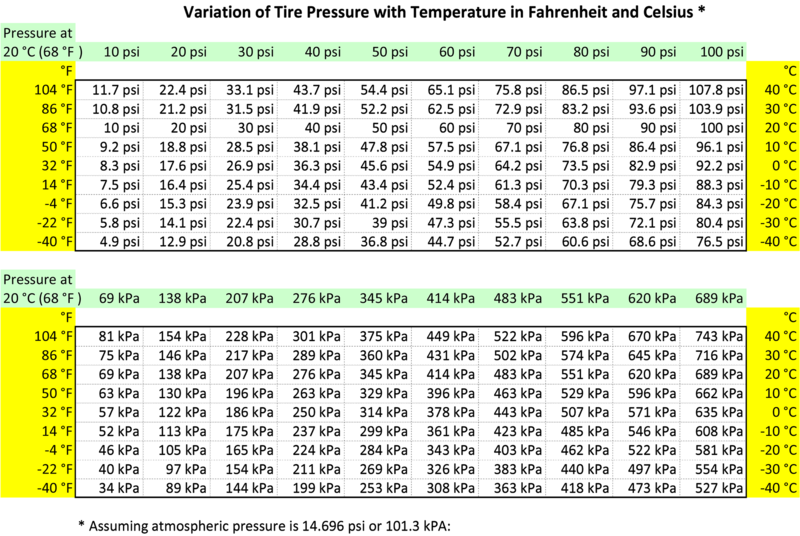Tire Pressure
Check Tire PSIGet recommended tire pressure for your car. View psi tire pressure chart according to your car wheel size and tire brand and do not forget checking production year of your car.
Importance Of Right PSI

Maintaining your tires is the most important thing you can do to insure the safety of your car on way.Driving on tires with incorrect air pressure, on the other hand, means disaster could strike any time - and at any speed.
The tire pressures specified for your vehicle are agreed to between the vehicle manufacturer and the tire producer. The psi (pound per square inch) is based on your vehicle's total weight and size, towing weight capability, and recommended tire size.

Tires also have a 'tread wear indicator' block set into them at a depth of 1.6mm. You should check this block to ensure that this indicator is not at the same level as or lower than the tyre tread.
Average PSI Pressure Values
List of car brands with average tire pressures.
- Acura32.94
- Alfa Romeo29.97
- Audi31
- BMW29.39
- Buick31.87
- Cadillac32.39
- Chevrolet30.72
- Chrysler29.3
- Citroen31.85
- Dacia32.27
- Daewoo33.04
- Daihatsu31.87
- Dodge29.5
- Jeep29.45
- Fiat30.5
- Ford33.25
- GMC32.81
- Honda33.75
- Hyundai33.41
- Infiniti32.46
- Isuzu30.2
- Jaguar32.69
- Kia31.4
- Lada29.86
- Lamborghini32.74
- Lancia33.35
- Land Rover30.15
- Lexus30.53
- Lincoln29.44
- Lotus32.98
- Mazda33.46
- Mercedes-Benz29.17
- Mini31.6
- Mitsubishi29.29
- Nissan32.53
- Peugeot29.28
- Renault31.04
- Saab32.63
- Saturn31.2
- Seat29.34
- Skoda33.06
- Smart33.24
- Subaru30.26
- Tata29.29
- Toyota31.91
- Volkswagen32.17
- Volvo31.69
To view single car model PSi value please check at the end of the index page.
WHEN SHOULD YOU CHECK YOUR CAR TIRE PRESSURE ?
The difference between cold nighttime temperatures and hot daytime temperatures in most parts of the country is about 10 C degree. This means that after setting tire pressures first thing in the morning, the vehicle's tire pressures will be almost 2 psi higher when measured in the afternoon (if the vehicle was parked in the shade). While that is expected, the problem is when you set your vehicle's tire pressures in the heat of the day, their cold pressures will probably be 2 psi low the following morning.
How To Check PSI AIR PRESSURE USING A PRESSURE GAUGE DEVICE ?
Regardless of the types, using a tire pressure gauge is relatively easy. It only involves a few basic steps which consist of the following.
- Take the cap of the tire valve. To do this you need to unscrew the valve stem or the black extension near the hubcap disk on the wheels.
- Attach the gauge. As to how to connect the instrument to the tire may slightly vary depending on what type of gauge you are using. For dial gauge, attach the valve end of the over the valve press system. If its a stick gauge, you need to take the open end of the stick gauge first before you can attach it to the tire's valve.
- Press the gauge against the tire nozzle. Do make sure no hissing sound is heard. Otherwise, this translates to air pressure escaping which could result in an inaccurate reading.
- Compare the measured psi to the psi found on the sticker inside the driver's door of your vehicle or in owner's manual. DO NOT compare to the psi on your tire's sidewall or PSITirePressure.com value.
- Replace the valve cap. The valve stem cap has a rubber seal designed to trap dirt and moisture away from the valve stem core that holds the air for your tires. Without the valve cap, air pressure escapes out of your tire and you'll end up with a flat tire.
Temperature Relation On Tire Pressures

Just as cold outside air causes the air inside your tires to contract in winter, warm outside air causes the air inside your tires to expand. The rule of thumb (best understood as our American counterparts put it) is that tire pressure will go up approximately one pound per square inch (PSI) for every 10 Fahrenheit increase in temperature. So, let's say your manufacturer's recommend inflation level is 35 PSI, on one of those all-time hot August afternoons, your tire pressure could be somewhere near 40 PSI.
Tire PSI Inflation Types:
Proper inflation: Properly inflated tires will have an equal distribution of tire tread contact with the road. This creates evenly distributed wear for the entire tire, allowing a smoother and safer ride.
Under inflation: Under inflated tires are caused by having little air pressure, which affects the outer tread edges, making them the only contact the road. This creates wear primarily on both edges of the tire tread, with less wear in the center.
Over inflation: Overly inflated tires are caused by having too much air pressure, this directly affects the tire's middle section, being the only point of contact to the road. This creates wear primarily in the center of the tread, with less wear at the tire's edges.
Car PSI Values :
Let's check car tire psi values.
- Volkswagen Parati
- Zagato Zeta
- Fiat Stilo
- Infiniti M35
- Abarth Ot 2000
- Bmw 1500
- Matra-simca Rancho
- Honda Sm-x
- Toyota Xyr
- Volkswagen Touran
- Pininfarina Enjoy
- Bond Equipe
- Daihatsu Mira
- Kia All-new
- Osca 1050
- Volkswagen Hac
- Zastava 2101
- Morris Ital
- Wanderer W
- Jaguar Xj
Check Tire Size
Let's check car tire sizes.
- 2003 Toyota Progres Tire Size
- 2012 Mazda Verisa Tire Size
- 2009 Peugeot Quadricycle Tire Size
- 2012 Mazda Mx-6 Tire Size
- 2016 Osi 1200 Tire Size
- 2021 Siata Amica Tire Size
- 2010 Subaru Vivio Tire Size
- 2012 Gaz 24 Tire Size
- 2008 Kia Sephia Tire Size
- 2003 La Buire 10 Hp Tire Size
- 2012 Spyker C12 Tire Size
- 2007 Audi Sq7 Tire Size
- 2008 Mercedes-benz W123 Tire Size
- 2019 Chevrolet Hhr Tire Size
- 2019 Toyota Prius 3 Tire Size
- 2006 Kia Xedos Tire Size
- 2008 Nissan Be-1 Tire Size
- 2005 Hillman 40 Tire Size
- 2014 Renault Megane 4 Tire Size
- 2000 Bugatti Type 23 Tire Size
